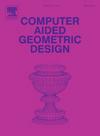进化多目标高阶四面体网格优化
IF 1.7
4区 计算机科学
Q3 COMPUTER SCIENCE, SOFTWARE ENGINEERING
引用次数: 0
摘要
高阶网格优化有很多目标,如提高平滑度、减少近似误差和提高网格质量。以往的方法不能同时优化这些目标,导致优化结果不理想。为此,我们提出了一种针对高阶网格的多目标优化方法。我们算法的核心是使用多目标遗传算法 (MOGA) 来适应多重优化目标。具体来说,我们逐个优化每个控制点,并在其中应用 MOGA。我们证明了我们的方法在各种模型中的可行性和有效性。与其他最先进的方法相比,我们的方法在多个目标之间实现了良好的权衡。本文章由计算机程序翻译,如有差异,请以英文原文为准。
Evolutionary multi-objective high-order tetrahedral mesh optimization
High-order mesh optimization has many goals, such as improving smoothness, reducing approximation error, and improving mesh quality. The previous methods do not optimize these objectives together, resulting in suboptimal results. To this end, we propose a multi-objective optimization method for high-order meshes. Central to our algorithm is using the multi-objective genetic algorithm (MOGA) to adapt to the multiple optimization objectives. Specifically, we optimize each control point one by one, where the MOGA is applied. We demonstrate the feasibility and effectiveness of our method over various models. Compared to other state-of-the-art methods, our method achieves a favorable trade-off between multiple objectives.
求助全文
通过发布文献求助,成功后即可免费获取论文全文。
去求助
来源期刊

Computer Aided Geometric Design
工程技术-计算机:软件工程
CiteScore
3.50
自引率
13.30%
发文量
57
审稿时长
60 days
期刊介绍:
The journal Computer Aided Geometric Design is for researchers, scholars, and software developers dealing with mathematical and computational methods for the description of geometric objects as they arise in areas ranging from CAD/CAM to robotics and scientific visualization. The journal publishes original research papers, survey papers and with quick editorial decisions short communications of at most 3 pages. The primary objects of interest are curves, surfaces, and volumes such as splines (NURBS), meshes, subdivision surfaces as well as algorithms to generate, analyze, and manipulate them. This journal will report on new developments in CAGD and its applications, including but not restricted to the following:
-Mathematical and Geometric Foundations-
Curve, Surface, and Volume generation-
CAGD applications in Numerical Analysis, Computational Geometry, Computer Graphics, or Computer Vision-
Industrial, medical, and scientific applications.
The aim is to collect and disseminate information on computer aided design in one journal. To provide the user community with methods and algorithms for representing curves and surfaces. To illustrate computer aided geometric design by means of interesting applications. To combine curve and surface methods with computer graphics. To explain scientific phenomena by means of computer graphics. To concentrate on the interaction between theory and application. To expose unsolved problems of the practice. To develop new methods in computer aided geometry.
 求助内容:
求助内容: 应助结果提醒方式:
应助结果提醒方式:


